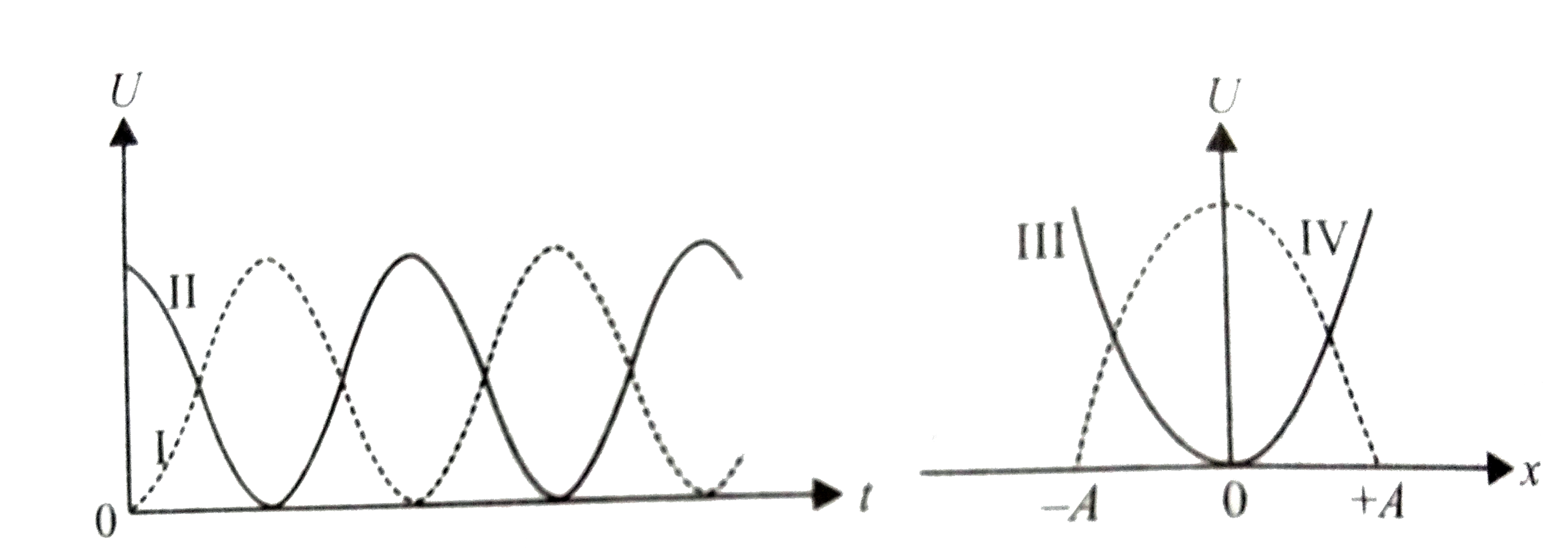A body is executing simple harmonic motion. At a displacement x, its potential energy is E1 and a displacement y, its potential energy is E2. The potential energy E at a displacement (x+y) is
E1+E2
√E21+E22
E1+E2+2√E1E2
√E1E2
The correct Answer is:C
To solve the problem, we need to find the potential energy E at a displacement (x+y) given the potential energies E1 and E2 at displacements x and y respectively.
1. Understand the Formula for Potential Energy in SHM:
The potential energy E in simple harmonic motion (SHM) is given by the formula:
E=12kx2
where k is a constant related to the mass and angular frequency of the motion, and x is the displacement.
2. Express E1 and E2:
For displacement x:
E1=12kx2(1)
For displacement y:
E2=12ky2(2)
3. Solve for Displacements x and y:
Rearranging equations (1) and (2) gives us:
x=√2E1k(3)
y=√2E2k(4)
4. Find the Total Displacement x+y:
The total displacement is:
x+y=√2E1k+√2E2k(5)
5. Calculate the Potential Energy at Displacement (x+y):
The potential energy at displacement (x+y) is:
E=12k(x+y)2(6)
Substituting equation (5) into equation (6):
E=12k(√2E1k+√2E2k)2
6. Simplify the Expression:
Expanding the square:
E=12k(2E1k+2E2k+2√2E1k⋅2E2k)
This simplifies to:
E=E1+E2+2√E1E2k
7. Final Relationship:
The relationship between E, E1, and E2 can be expressed as:
√E=√E1+√E2
Conclusion:
Thus, the potential energy E at a displacement (x+y) is given by:
E=(√E1+√E2)2
The potential energy E in simple harmonic motion (SHM) is given by the formula:
E=12kx2
where k is a constant related to the mass and angular frequency of the motion, and x is the displacement.
For displacement x:
E1=12kx2(1)
For displacement y:
E2=12ky2(2)
Rearranging equations (1) and (2) gives us:
x=√2E1k(3)
y=√2E2k(4)
The total displacement is:
x+y=√2E1k+√2E2k(5)
The potential energy at displacement (x+y) is:
E=12k(x+y)2(6)
Substituting equation (5) into equation (6):
E=12k(√2E1k+√2E2k)2
Expanding the square:
E=12k(2E1k+2E2k+2√2E1k⋅2E2k)
This simplifies to:
E=E1+E2+2√E1E2k
The relationship between E, E1, and E2 can be expressed as:
√E=√E1+√E2
Thus, the potential energy E at a displacement (x+y) is given by:
E=(√E1+√E2)2
Topper's Solved these Questions
Similar Questions
A body is executing simple harmonic motion. At a displacement x (from its mean position) its potential energy is E1 and at a displacement y its potential energy is E2. The potential energy is E at displacement (x+y) . Then:
View SolutionA body is performing SHM At a displacement X1, its potential energy is 4 J and at a displacement X2, its potential energy is 9 J. The potential energy at a displacement (X1+X2) is
View Solution
Knowledge Check
A body executes simple harmonic motion. At a displacement x, its potential energy is U1. At a displacement y, its potential energy is U2. What is the potential energy of the body at a displacement (x + y)?
AU1+U2B(√U1+√U2)2C√U21+U22D√U1U2A particle is executing simple harmonic motion. Its total energy is proportional to its
Adisplacement from equilibrium positionBfrequency of oscillationCsquare of amplitude of motionDvelocity at equilibrium positionA particle executing SHM with an amplitude A. The displacement of the particle when its potential energy is half of its total energy is
AA√2BA2CA4DA3
In a simple harmonic motion, when the displacement is one-half the amplitude, what fraction of the total energy is kinetic ?
View SolutionIf a body is executing simple harmonic motion and its current displacement is √3/2 times the amplitude from its mean position , then the ratio between potential energy and kinetic energy is
View SolutionAt what displacement the kinetic is equal to the potential energy ?
View SolutionIn simple harmonic motion of a particle, maximum kinetic energy is 40 J and maximum potential energy is 60 J. then
View SolutionFor a particle executing simple harmonic motion, the displacement x is given by x=Acosωt. Identify the graph, which represents the variation of potential energy (U) as a function of time t and displacement x.

View Solution
